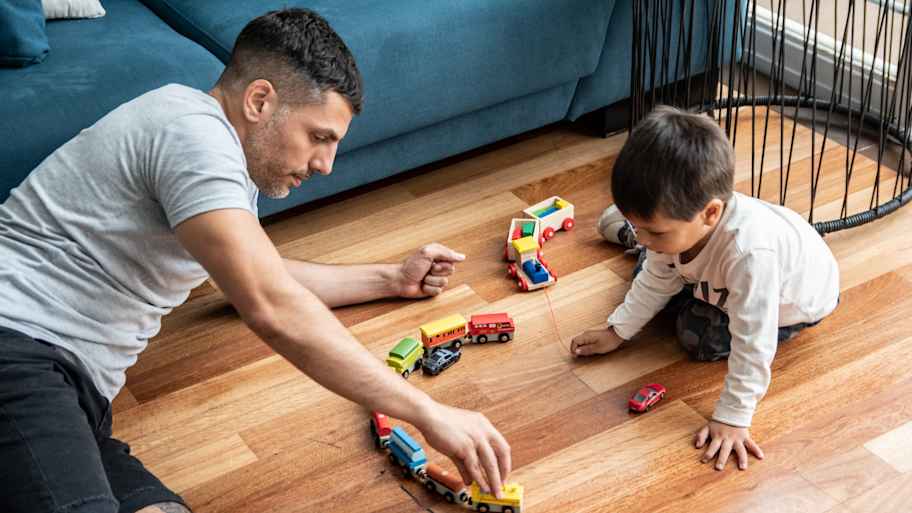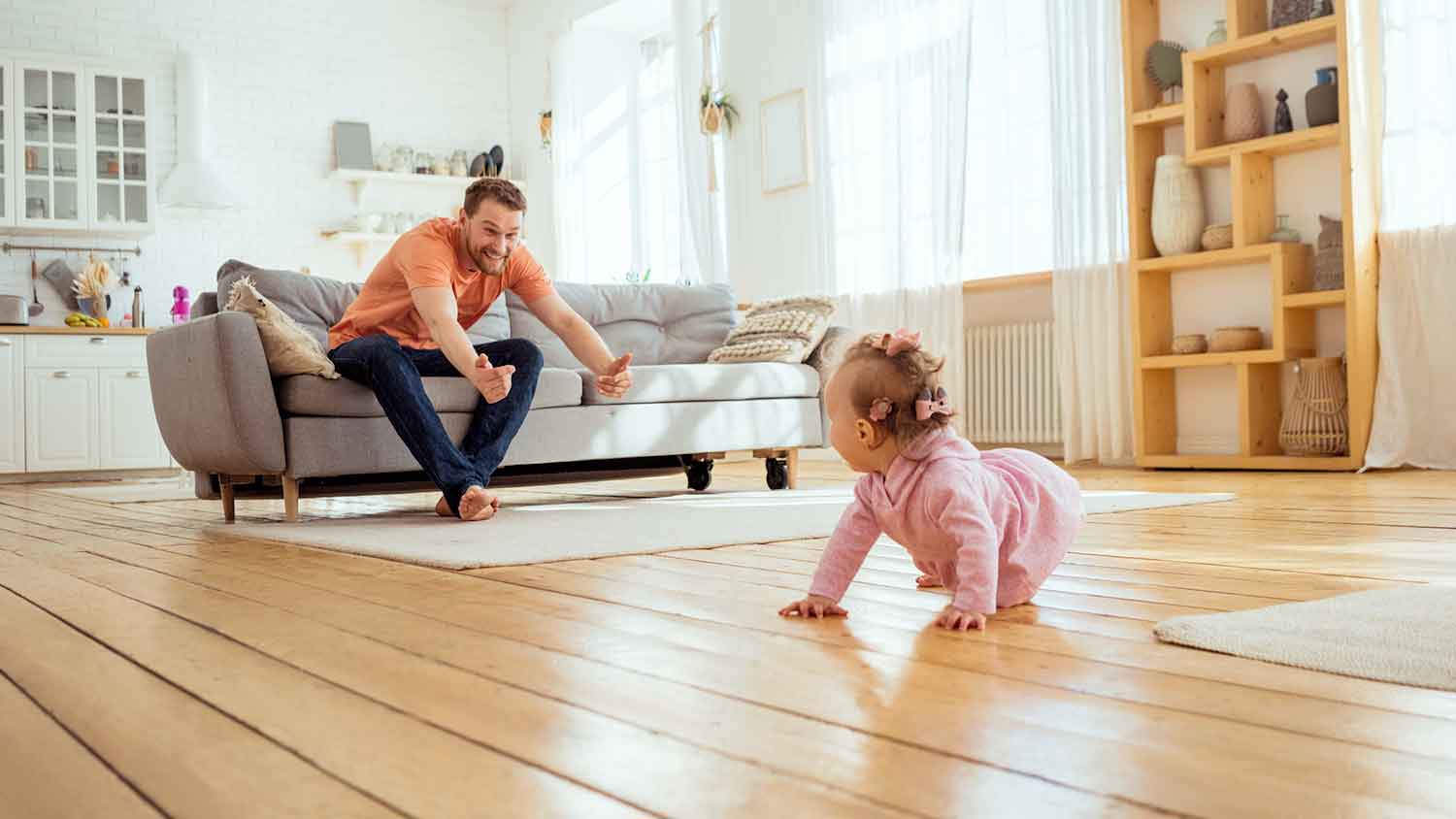
Here’s what you should expect to pay when renting an orbital, drum, vibrating, or edging floor sander—as well as where you can rent them and what else to know.
Refresh your hardwood floors with a new coat of paint


Professional painters charge about $20 to $50 per hour, but they’ll also handle prepwork and cleanup before and after painting your hardwood floors.
DIYers might not have the proper equipment, including a floor sander, wood filler and repair tools, various painting supplies, and protective gear.
Hiring a wood floor refinishing pro prevents issues like peeling, bubbling, discoloration, and even damage to your hardwood floors.
You want to give your hardwood floors a makeover, but you don’t want to deal with all the hassle and cost of refinishing them. Learning how to paint hardwood floors can be a great solution as you can likely DIY the job and save money in the process. Follow this guide if painting your wood floor is for you.
Maybe you’re not feeling your floor anymore, but you don’t want to splurge on the cost to refinish hardwood floors. This has left you wondering—can you paint hardwood floors? The answer is an enthusiastic yes. Whether it’s the best option for you depends on what you’re trying to achieve.
Some examples of when painting wood floors is a good option are if you’re budget-conscious, want to DIY a solution, and painted floors would fit your home’s vibe. Painted floors may look out of place in a sleek, modern home, but they’ll look great if your house has an artsy, rustic, or country aesthetic.
On the other hand, painting floors in a high-traffic area may mean that you’ll see wear and tear within the first couple of years. This is a big difference when compared to refinishing your floors, which can keep your floors in good condition for seven to 10 years.
When prepping to paint your hardwood floors, you should start by choosing the color you want for your new floor. Some popular paints for wood flooring include variations of white, black, blue, and green.
Once you have an idea of the color you want, you can move on to choosing your paint. You can go with either oil-based or water-based primer, paint, and sealant. Generally, it’s easier to use water-based products because some of these paints have lower-VOC levels and dry faster. Also, oil-based sealants can yellow over time, so it’s best to stick with water-based sealants.
Think about the space you plan to paint, and whether it’s a low-traffic or high-traffic area. For the latter, you can use anti-slip paint and sealant with special additives.

You’ve chosen your paint colors and you’re ready to get this job rolling. Here are the steps to get the painting done from beginning to end.
First, you have to remove everything from the room including all of the furniture and rugs. Then, clean the hardwood floor as best you can with a broom and mop. Allow it to completely dry before moving on to the next step.
Once the floor is dry, get your painter’s tape and tape off all of your baseboards and any molding. You don’t have to remove the baseboards as long as you do this step, which will save you a lot of time.
As you cleaned your floor, you may have noticed small imperfections in the wood. You can fix any small cracks and holes with putty. Look for a product that doesn’t shrink.
If there are any loose boards, hammer them down. Check that all of your nails are at least 1/8” below the surface so they don’t snag on your sander.
To help the paint properly stick to your wood floors, you have to sand it to give it texture. Wear a dust mask, and if applicable, throw on some kneepads to make this process easier on your legs. Also, to prep for the sanding, cover up any air grills with plastic. Also, turn off your HVAC so you don’t circulate the dust.
To get the sanding job done, you can use a handheld electric sander with 120-grit sandpaper. If you have a large space that you’re painting, you might consider renting a drum sander and an edger from your local flooring or hardware store. Once you finish sanding the floor with the tools, you can use a carbide scraper to sand the hard-to-reach corners in your room.
When you finish sanding, get all of the dust cleaned up using a vacuum. Next, wipe the floors down with a damp cloth using hot, soapy water. Do another wipe-down with just water, and then sop up all the moisture you can with a dry towel. Let the floors dry overnight before proceeding to the next step.
Get your primer and start applying it from one corner of the room while moving toward the exit. Plan your painting path ahead of time, so you don’t accidentally paint yourself into a corner with no way out.
You may consider tinting your primer to match the paint color. This helps preserve your wood floor longer, because if the first layer of paint peels or chips off, the exposed primer won’t stand out so much.
For the best results, start applying the primer with a 2 1/2-inch angle sash brush, use a cutting brush for the corners, and then finish up with a roller with an extension pole.
Allow the primer to completely dry before moving onto the next step. This usually takes a day, but check the manufacturer’s instructions for drying times.
You should apply at least two coats of paint. Start with a hand-holding brush or a low-nap mohair roller and use a cutting brush for the corners. For large spaces, you can switch to a roller with an extension pole. Paint with the grain of the wood and focus on painting one to four floorboards at a time, depending on the size of your brush or roller.
After you apply the first coat of paint, wait at least eight hours (or follow the paint instructions for a drying time) before moving on to the second coat.
If the room is a high-traffic area, consider applying a third coat of paint to improve the appearance and increase the chances of your paint lasting longer.
The last step is the sealant. You should apply at least four layers of a water-based sealant. Most products require you to wait about two to three hours between coats.
After you finish applying the sealant, let your floor cure for 12 hours. When your waiting period is up, remove the tape from your baseboards and molding.
It’s best to wait an additional 12 hours before you start allowing light foot traffic in the space, and another 60 hours before heavy foot traffic. When this final waiting period is over, you can start moving your furniture back into the room.

Painting hardwood floors takes several days when you factor in all the drying times. So it’s best to plan ahead, especially if you’re painting a room that normally gets a lot of foot traffic.
While you work, youcan put some extra rags at the exit and entry points for makeshift doormats, or put a real doormat there. If you decide to use an oil-based primer, paint, or sealant, be careful to create proper ventilation and wear masks and goggles.
And finally, think ahead about whether you really want light-colored painted floors. It’s a very popular option since it gives such a nice aesthetic, and white floors brighten up rooms and make smaller spaces feel bigger. However, any dirt or grime will show up a lot easier on a white floor compared to a dark-colored floor, so you might end up spending more time cleaning than you might expect. You may also want to consider how you’ll transition between two different wood floor colors.
Painting your hardwood floors is a doable DIY project for people who have some painting knowledge and enough time to get it done. And as long as you opt for water-based products, you don’t have to worry about high levels of chemical fumes.
However, it does take some elbow grease. The bigger the space you want to paint, the more effort and time it’ll take. Even for smaller areas, painting the floor can be a big job because it requires so many steps and multiple coats of different products.
Whether you don’t have the time or inclination to take this job on yourself, you can always hire a painter near you to help with the job. You can expect painters to charge about $20 to $50 per hour.
However, if you decide to go with a refinishing project instead of painting your floors, you can call a local hardwood floor refinishing pro to help you restore your floors. Hardwood floor refinishing typically costs $1,100 to $2,700.
From average costs to expert advice, get all the answers you need to get your job done.

Here’s what you should expect to pay when renting an orbital, drum, vibrating, or edging floor sander—as well as where you can rent them and what else to know.

It’s impossible to keep floors damage-free over the years. Thankfully, the cost to refinish hardwood floors is far less than the price tag to replace them altogether.

Hardwood floor repair costs depend on the problem. This guide breaks down common costs based on factors like the type of problem, repair method, and whether you hire a pro or DIY.

Unsure who to hire for hardwood floor refinishing? A professional floor refinisher is the answer. They provide guaranteed results and save you time and energy.

Get the look of hardwood at a fraction of the cost. This guide will help you understand the cost to install engineered hardwood floors in your home.

Are you wondering whether to choose engineered wood or hardwood flooring? We break down the pros, cons, costs, and differences so you can choose with confidence.